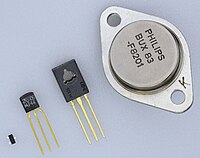
Photo from wikipedia
The p-n-p bipolar junction transistors (BJTs) are susceptible to surface recombination in both the emitter-base depletion and neutral base (NB) regions when their passivation oxide layers are damaged by ionization… Click to show full abstract
The p-n-p bipolar junction transistors (BJTs) are susceptible to surface recombination in both the emitter-base depletion and neutral base (NB) regions when their passivation oxide layers are damaged by ionization irradiation, leading to an increase of base current. The previous model of excess base current proposed in 2015 omits the damage in the NB and the impact of oxide charges, which results in an underestimation of bias sensitivity of excess base current. This work presents a physics-based improvement of the previous model, and it provides a much better fit to the experimental data for the bias dependence of excess base current for the 2N2907 vertical and gate-controlled lateral p-n-p BJTs subjected to $\gamma $ -ray irradiation. The model suggests that the damage in the NB can be significant for a lateral p-n-p with a wide base, operated at high bias voltage, and exposed to a low dose. Furthermore, the model provides a simple and practical method to separate and estimate the total oxide charge and increased interface trap densities from excess base current readings on irradiated p-n-p BJTs. The extracted values of interface trap densities show less dependence on E-B bias voltage than with previous models, which provides evidence of its improved precision.
Journal Title: IEEE Transactions on Nuclear Science
Year Published: 2020
Link to full text (if available)
Share on Social Media: Sign Up to like & get
recommendations!